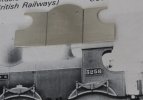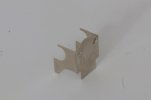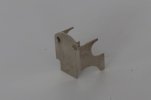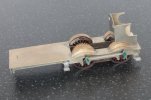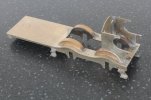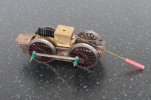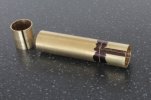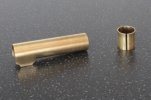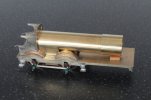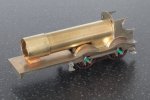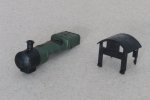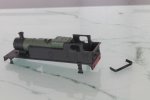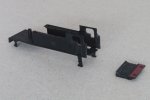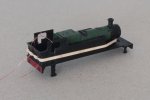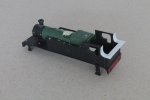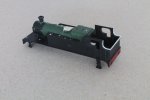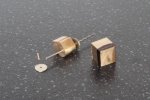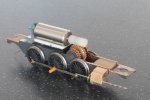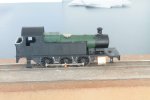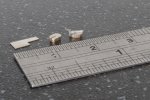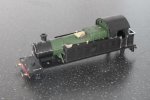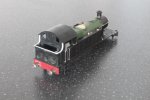A couple of weeks ago I went along to TINGS (The International N Gauge Show) to help my friend Benn with his "Barton Road" layout. While there I had a look at what was on offer on the Dapol stand - not something I would normally do as RTR N Gauge holds little to no interest for me - however, on sale was a "Wobbly & Stuttering" 45xx for £25. I parted with the necessary cash and with Modbury's next outing just a few weeks away (now just a couple of weeks), I thought I could do a "quicky" to add to the Modbury loco roster. This post relates the progress so far.
I have to say that I was a bit disappointed when I opened the box as it purports to be 4518 (an early member of the class with straight tanks), but what I actually got was a 4575 class (a 45xx with larger sloping tanks).
I've always had a bit of a soft spot for these small prairie locos, and a 45xx was one of my failed attempts at 2mm Finescale loco building from the 1980's. A result of that failure is that I still have a full set of wheels in readiness for this project, albeit the old white metal wheels with steel tyres.
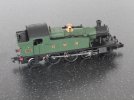 The Dapol loco as purchased (or nearly so, as I have stripped and rebuilt the N Gauge chassis so that it will actually move - although not well). Obviously, I didn't actually give a hoot about the N Gauge chassis as I will be replacing it anyway!
The Dapol loco as purchased (or nearly so, as I have stripped and rebuilt the N Gauge chassis so that it will actually move - although not well). Obviously, I didn't actually give a hoot about the N Gauge chassis as I will be replacing it anyway!
The first thing (after fixing the N Gauge chassis) was to measure the loco and compare it to drawings of the 45xx class in Great Western Journal's Now 2 & 16. It was then a simple matter of drawing up in CAD a set of frames that will fit under the N Gauge body. I had decided to scratch build a chassis rather than purchase the chassis David Eveleigh has produced, I don't quite know whether David's chassis is "wrong", but I have seen at least three 2mm Finescale 45xx's all suffering from the same affliction - the cylinders don't line up correctly with the outside steam pipes (the pipes should line up with the centre of the cylinders whereas the models I've seen have the pipes offset toward the front of the cylinders!)
I will be using a Nigel Lawton 8mm motor in this engine, driving a 30:1 worm/gear, then using 18/22 tooth spur gears onto the leading driving axle. This arrangement was also included in the CAD, and once happy with the arrangement the drawing was printed out (at scale). The drawing was superglued to a couple of laminations of 0.25mm phosphor bronze strips, and the piercing saw and files brought to bear.
Before cutting the frames out however, I had to cobble up some coupling rods by cutting and splicing from Association etched coupling rods. To aid in this, I set up my lathe with the vertical slide so I could attach a sheet of tufnol to it to drill a set of three 0.5mm holes at crankpin centres. Putting chemically blackened pins in these holes allowed the coupling rods to be assembled without getting soldered to the pins.
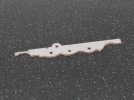 The basic frames fretted out of a laminated pair of phosphor bronze strips. The axle holes were pilot holed 0.5mm using the previously made coupling rods, then opened out to 1.5mm for the axles. The slot in the top of the frames just forward of the leading driving wheel axle hole is where the motionn bracket will eventually attach.
The basic frames fretted out of a laminated pair of phosphor bronze strips. The axle holes were pilot holed 0.5mm using the previously made coupling rods, then opened out to 1.5mm for the axles. The slot in the top of the frames just forward of the leading driving wheel axle hole is where the motionn bracket will eventually attach.
A couple of lengths of 6.4mm wide double sided PCB were cut for the chassis spacers (1.6mm thick), and an extra 0.5mm thick piece of double sided PCB was cut to go above the front pony truck.
A couple of photos of the resultant chassis - although before it was assembled, I drilled further holes for the brake hanger pivots and also for "Simpson" springs. I've also drilled a couple of holes where the outside cylinders will eventually go - I intend to file the cylinders from solid brass blocks, which will be pegged and glued to the frames, the holes are for the pegs.
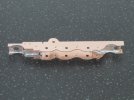
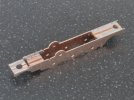
And finally for now, the chassis sitting below the Dapol body :
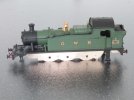
Earlier today, I trial fitted the wheels and was absolutely astonished that when once quartered all I had to do was open out the crankpin holes to 0.55mm to have smoothly rolling chassis. It seems a shame that I've got to strip it down in order to paint it!!
Thanks for looking
Ian
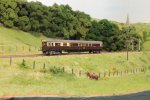
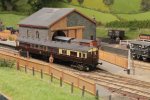
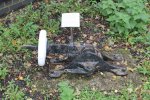
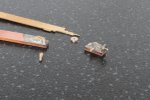
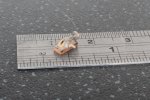
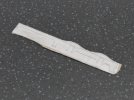
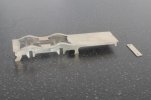
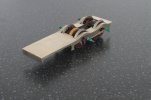
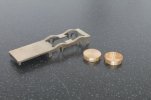
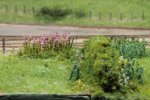
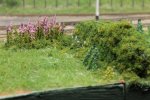
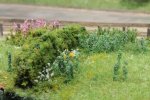
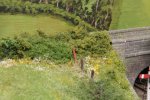
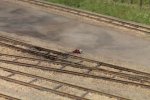

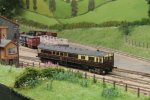
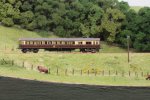
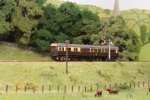
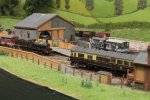
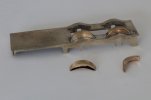
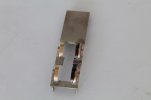
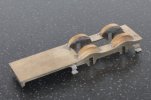 The steps were then added to the uprights - these were cut and folded up from strip of 0.004" nickel silver.
The steps were then added to the uprights - these were cut and folded up from strip of 0.004" nickel silver.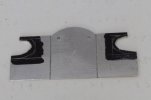 The cab sides and front cut to overall size and shape before the side cutouts were filed to shape. The rough shape of the cut outs was marked on the part with a needle so that the majority of the waste could be removed with a piercing saw to save filing time.
The cab sides and front cut to overall size and shape before the side cutouts were filed to shape. The rough shape of the cut outs was marked on the part with a needle so that the majority of the waste could be removed with a piercing saw to save filing time.